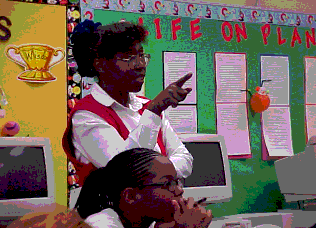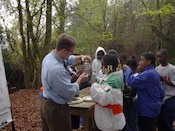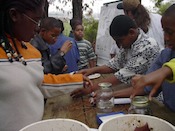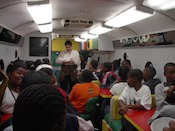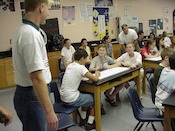TEEMS Class 2001
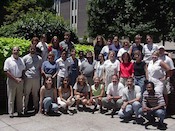
A TEEMS cohort of about 25 graduate students. I co-taught this group with Brian Muma, Mike Dias, and Charles Hutchison, who at the time were working on their Ph.D.'s. Each is now a professor at Georgia College & State University, Kennesaw State University, and the University of North Carolina, Charlotte, respectively.
Rocket builders

TEEMS interns and their students after successfully building and launching rockets.
TEEMS is a constructivist approach to science teacher education, and is based on an active-learning model, and was based on nearly ten years of experience with alternative teacher preparation.
The Department of Middle Secondary Education and Instructional Technology (MSIT) was the first department at Georgia State University (GSU) to provide alternative paths to the teaching profession. Starting in 1970, with the Science Education Phase Program (Phases) teacher education programs in science have been developed, as well as alternative teacher education programs, leading to teaching certificates in foreign language, mathematics and science. Through cooperative efforts among GSU, the Georgia Professional Standards Commission and many school districts throughout the state, more than 80 teachers began teaching careers through the TRIPS Program, and the Alternative Teacher Preparation Program in Foreign Language, Mathematics and Science.
One of the outcomes of these alternative teacher preparation programs was to rethink the nature of teacher education, and to begin to visualize and plan for new approaches to teacher education. As a result of the convergence of our work in alternative teacher preparation, the apparent American national crisis in science and mathematics, and the emerging epistemology of constructivism as developed by Ernst von Glassersfeld, a new program for the preparation of mathematics and science teachers was developed.
TEEMS FRAMEWORK. The underlying framework for the new program is social constructivism, which suggests that human beings construct knowledge through acting on their environment and interacting with other humans. In practical terms we accepted the notion that students entering this new teacher education program would have preconceptions about how to teach and how they think children learn science. As many researchers have reported, these preconceptions are resistant to change using traditional methods. To deal with this within a new framework would mean the program design would be based on an experiential and active learning model in which students would work in collaborative groups on problem solving activities and participate in reflective activities. In this way, they could monitor their ideas, and reconsider the preconceptions they had and consider alternative theories and ideas based on practical work. The work to design, and eventually implement this new program was called the TEEMS Program (Teacher Education Environments in Mathematics and Science).
Philosophically, the program encourages the construction of teaching strategies and models through an active learning format beginning in the Summer term. Students are involved in handson/mindson strategies designed to help them create active learning environments for the students they will teach. An integration of theory and practice characterizes the work that we have planned for our students. Even in the Summer, TEEMS students work with teenagers in an environmental science environment. Pedagogy and practice are seen as twin vistas to help TEEMS students develop the knowledge of their craft.
The TEEMS program is designed to prepare secondary science teachers who possess a range of knowledge, abilities and skills including:
A thorough grasp of the knowledge base undergirding teaching practice based on constructivism, a repertoire of instructional strategies both of which result from emersion in an inquiry-based and reflective program. An understanding and the ability to use methods of inquiry and research findings in making professional decisions. A thorough grasp of a philosophy of teaching that is based on reflective thinking, inquiry and experiential learning. Appreciate the ethical and moral responsibilities of teaching.
During
the Fall, TEEMS students focus their work in a middle school by designing
lessons, working side-by-side with a mentor, and carrying out a science
education research project. In the Winter/Spring term, TEEMS students
participate in a practicum at a high school. In addition to working with a
mentor, students design evaluation and technology projects that are carried out
on-site. TEEMS students monitor their work throughout the year by maintaining a
professional portfolio. The portfolio showcases the TEEMS students' progress
and work by the inclusion of documents and artifacts that reflect work over the
course of a year. Near the later part of the Summer term, students present
their portfolios at a "science fair" type gathering.
Program
Characteristics
- Reflective
and constructivist models of learning
- Holistically
organized pedagogical curriculum experiences
- Learner-centered
instruction in which students engage in a series of experiential and
field-based experiences to learn about mathematics and science teaching
- A partnership
with the public and independent schools of Georgia by centering much of
the instruction in middle schools and high schools
Using Minds on
Science with the TEEMS supported
this realistic view of teacher education, but it also provided an opportunity
to gather feedback to evaluate the strengths and weakness of the book in a
teacher education environment. I assumed that the publisher would want to
publish a second edition, and was gathering information that would be helpful
for changing the book. The book went through several printings, and
instead of a second edition, Minds on Science was published on the Internet hosted by the science
education server at GSU.
Doctoral Student Participation. During this period of time a cadre of Ph.D. students came to GSU to pursue
doctorates in science education. Many of them were involved in the TEEMS
program as teaching associates during the summer, or mentor teachers during the academic year, while others
pursued research interests related to the Global Thinking Project. However, since nearly all of them were practicing secondary science teachers,
they provided a crucial link between the university environment and realistic
environment of the schools. The teaching faculty of TEEMS was always
comprised of university professors, and these doctoral students were at the
same time high school science teachers.
Mike Dias was a
member of this cadre of doctoral students in science education at GSU.
When Mike came into the Ph.D. program he was teaching high school biology at
Harrison High School in Kennesaw, Georgia. I asked Mike if he and his
colleagues in the science department would be interested in serving as mentors
for the TEEMS program, and they graciously accepted our request. For the
next several years, Harrison High School became one of the centers for the
preparation of TEEMS students, along with schools in DeKalb County (Dunwoody
High School), Fulton County, Atlanta Public Schools, Clayton County, and
Rockdale County. More importantly, I spent a lot of time in Mike’s
classroom, and developed a personal and professional relationship with him
beginning in the late 1990s.
Mike
teamed up with Tom Brown, a colleague at Harrison High School, and an other of
the cadre of Ph.D. students in science education at GSU to develop a Summer
Science Camp for elementary and middle school students in the summer at
Harrison High School. Mike invited the TEEMS students to participate as
interns in the program, and for several summers, GSU’s TEEMS were going to
science camp for their first teaching experience. Mike coordinated the
efforts so that each of the TEEMS graduate students was part of teaching group
responsible for designing and implementing science inquiry activities with the
camp students. The experience became a good starting point for our
teacher interns, and gave them an opportunity to develop knowledge about
teaching, and develop the reflective tools that they would carry forward into
their full time internships which would begin the fall semester.
From 1994 until 2003, 145 men and women became middle and high school science teachers as a result of the TEEMS program that was based on the philosophy and pedagogy and pedagogy of Minds on Science. Their brilliance and creativity, shown in their internship work and from reports we received of their work in school science, fostered the development of a TEEMS philosophy and provided enormous encouragement and support for the work of the faculty working with them during their degree program. It also provided the opportunity for a formative assessment of Minds on Science, and set the stage for a new book.
